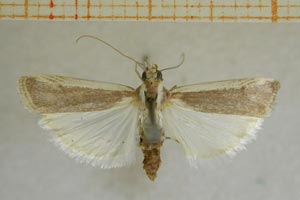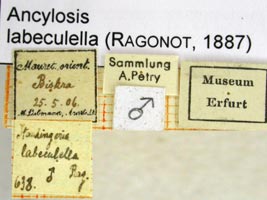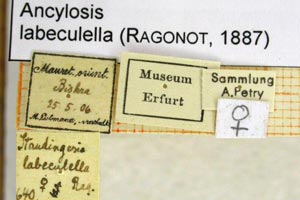

 +5Kontinente:EUAF
+5Kontinente:EUAF2. Diagnose
2.1. Männchen
2.2. Weibchen
2.3. Erstbeschreibung
3. Biologie
3.1. Nahrung der Raupe
- [Plumbaginaceae:] Limoniastrum guyonianum
Leraut (2014) nennt - ohne Quelle - Limoniastrum guyonianum als Raupennahrung. Da diese Pflanze sowohl auf Zypern als auch den Kanaren fehlt, kommt dort als Erstens Limoniastrum monopetalum in Frage.
4. Weitere Informationen
4.1. Andere Kombinationen
- Staudingeria labeculella (Ragonot, 1887) [Originalkombination]
4.2. Taxonomie und Faunistik
Typenlokalitäten von A. labeculella sind Gabès (Tunesien) und Biskra (Algerien). Die Art fehlt - sieht man von dem möglicherweise dieser Art zuzuordnenden Einzelnachweis von Staudingeria yerburii auf Ibiza ab - in Europa i.e.S., wurde aber sowohl für die Kanarischen Inseln als auch für Zypern genannt. Da A. labeculella später als Synonym zu Ancylosis yerburii (Butler, 1884) gestellt wurde, landeten die entsprechenden Angaben bei jener Art. Leraut (2014: 415) stellte fest: "Examination of different types of taxa associated with the species contained in the MNHN in Paris led the author to consider that two species were intermingled under the name of yerburii, the true A. yerburii Butler and Ancylosis labeculella (Ragonot, 1887), bona sp." Für A. yerburii ergab sich als gesichertes Verbreitungsgebiet "North Africa (Morocco, Algeria, Tunisia), Middle East", für A. labeculella "North Africa (Algeria, Tunisia)"; für Europa blieb nur "Presence in Europe uncertain (hitherto confused with the following species)" bzw. "Presence in Europe and Canaries uncertain (species up to now confused with the preceding one)".
Barton (2018) meldet jetzt ein von Jan Asselbergs aktuell als A. labeculella bestimmtes Exemplar von Zypern: "Akrotiri dunes, 30.ix.2014, specimen IB2060, ♂ , slide 834 (det. JA)." Damit ist zumindest diese Art für Europa bestätigt. Ob die Kanaren-Tiere zwischenzeitlich überprüft wurden, weiß ich nicht. Ancylosis yerburii wurde für Europa zwischenzeitlich aus dem Süden Russlands bestätigt. Zu überprüfen ist hier aber noch die Erstmeldung von A. yerburii für die Balearen (Ibiza) durch Férriz et al. (2006).
(Autor: Erwin Rennwald)
4.3. Publikationsdatum der Erstbeschreibung
28. Dezember 1887 (Begründung siehe unter Acrobasis niveicinctella).
4.4. Literatur
- Barton, I. (2018): A second contribution to the Lepidopteran fauna of Cyprus, presenting records for 48 taxa from 17 families. — Entomologist’s Record and Journal of Variation 130: 29-39.
- Butler, A. G. (1884): On a Collection of Lepidoptera made my Major J. W. Yerbury at or near Aden. — Proceedings of the scientific meetings of the Zoological Society of London for the Year 1884: 478-503, pl. XLVI.
- Férriz, I., Honey, M.R. & N.J. Riddiford (2006): Els Heterocers del parc natural de ses 199 Salines d'Eivissa i Formentera,(Illes Balears). The Heterocera of the Natural parc of ses Salines d'Eivissa and Formentera (Balearic Islands). — Bolletí de la Societat d'HistOria Natural de les Balears, 49: 199-211. [PDF auf ibdigital.uib.es]
- Leraut, P. (2014): Moths of Europe. Volume 4. Pyralids 2. - 441 S.; Verrières-le-Buisson (N.A.P Editions).
- Erstbeschreibung: Ragonot, E.-L. (1887): Diagnoses d'espèces nouvelles de Phycitidae d'Europe et des pays limitrophes. — Annales de la Société entomologique de France. 6e série 7 (3): 225-260. Paris.













